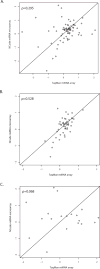Comparison of microarray and quantitative real-time PCR methods for measuring MicroRNA levels in MSC cultures
- PMID: 21431535
- PMCID: PMC4442613
- DOI: 10.1007/978-1-60761-999-4_30
Comparison of microarray and quantitative real-time PCR methods for measuring MicroRNA levels in MSC cultures
Abstract
The capacity for self-renewal and the multilineage potential of mesenchymal stromal cells (MSC) offer a therapeutic promise for regenerative medicine. MicroRNAs (miRNAs) are small noncoding RNAs that play a key regulatory role during differentiation both at the level of posttranslational modulation and epigenetic control. Studies on MSCs have just begun to identify miRNA profiles in MSC and differentiated MSC. While several methods are available for miRNA exploration, microarrays and quantitative real-time PCR (qPCR) are the most common. Since there are several microarray and qPCR platforms available for miRNA detection, it is valuable to explore how these methods compare. We used the NCode Multi-Species miRNA microarray (Invitrogen) and the TaqMan Human microRNA array (Applied Biosystems) to compare microRNA expression in undifferentiated MSCs and MSCs differentiated into early osteoblasts. We show that while there is a somewhat low correlation between these two methods, there is a subset of miRNA measurements that did correlate.
Figures

References
-
- Wagner W, Wein F, Seckinger A, Frankhauser M, Wirkner U, Krause U, Blake J, Schwager C, Eckstein V, Ansorge W, Ho AD. Comparative characteristics of mesenchymal stem cells from human bone marrow, adipose tissue, and umbilical cord blood. Exp Hematol. 2005;33:1402–1416. - PubMed
-
- Mansilla E, Marin GH, Drago H, Sturla F, Salas E, Gardiner C, Bossi S, Lamonega R, Guzman A, Nunez A, Gil MA, Piccinelli G, Ibar R, Soratti C. Bloodstream cells phenotypically identical to human mesenchymal bone marrow stem cells circulate in large amounts under the influence of acute large skin damage: new evidence for their use in regenerative medicine. Transplant Proc. 2006;38:967–969. - PubMed
-
- Igura K, Zhang X, Takahashi K, Mitsuru A, Yamaguchi S, Takashi TA. Isolation and characterization of mesenchymal progenitor cells from chorionic villi of human placenta. Cytotherapy. 2004;6:543–553. - PubMed
-
- In ’t Anker PS, Scherjon SA, Kleijburg-van der Keur C, Noort WA, Claas FH, Willemze R, Fibbe WE, Kanhai HH. Amniotic fluid as a novel source of mesenchymal stem cells for therapeutic transplantation. Blood. 2003;102:1548–1549. - PubMed
-
- in ’t Anker PS, Noort WA, Scherjon SA, Kleijburg-van der Keur C, Kruisselbrink AB, van Bezooijen RL, Beekhuizen W, Willemze R, Kanhai HH, Fibbe WE. Mesenchymal stem cells in human second-trimester bone marrow, liver, lung, and spleen exhibit a similar immunophenotype but a heterogeneous multilineage differentiation potential. Haematologica. 2003;88:845–852. - PubMed
Publication types
MeSH terms
Substances
Grants and funding
LinkOut - more resources
Full Text Sources
Other Literature Sources

